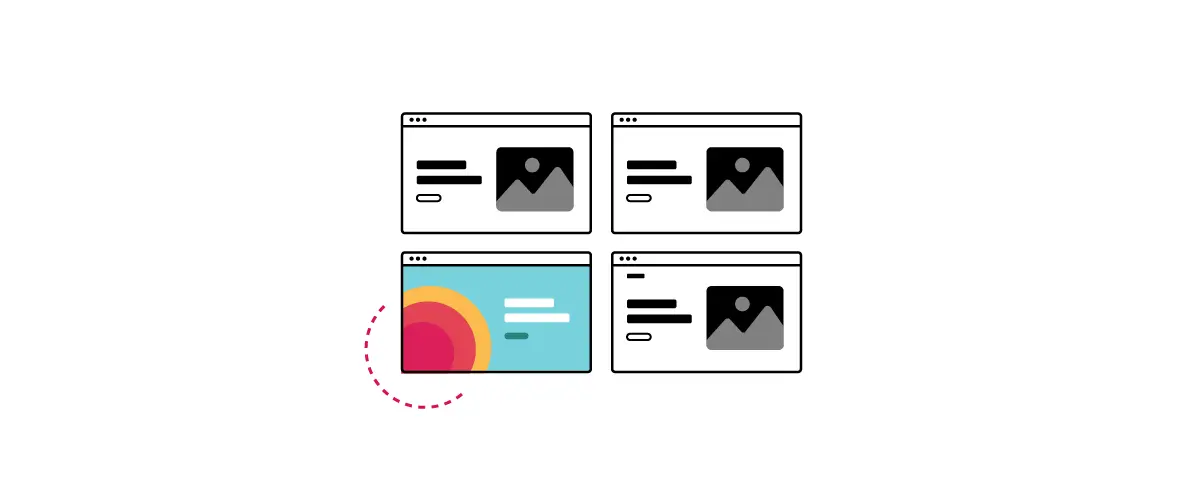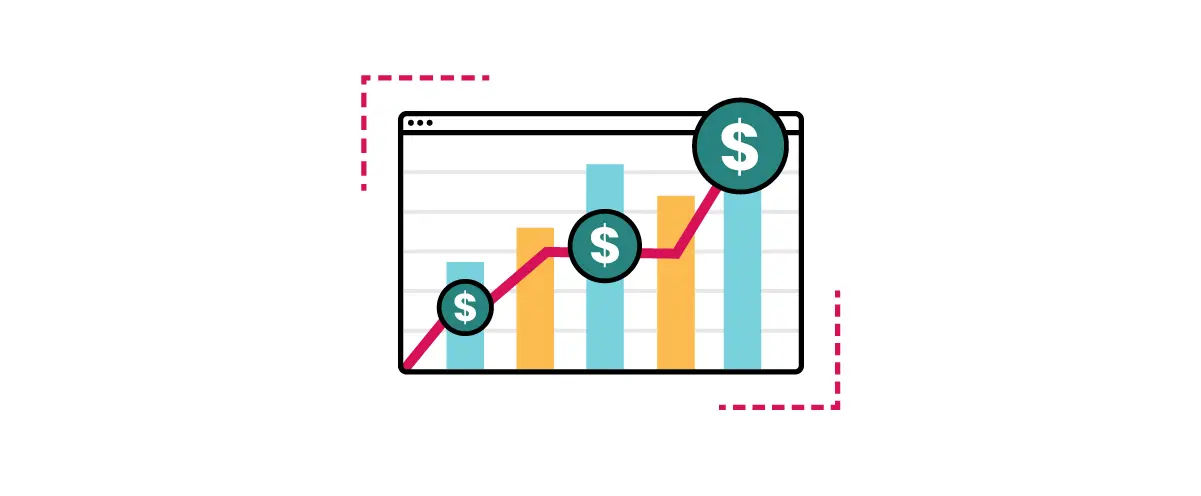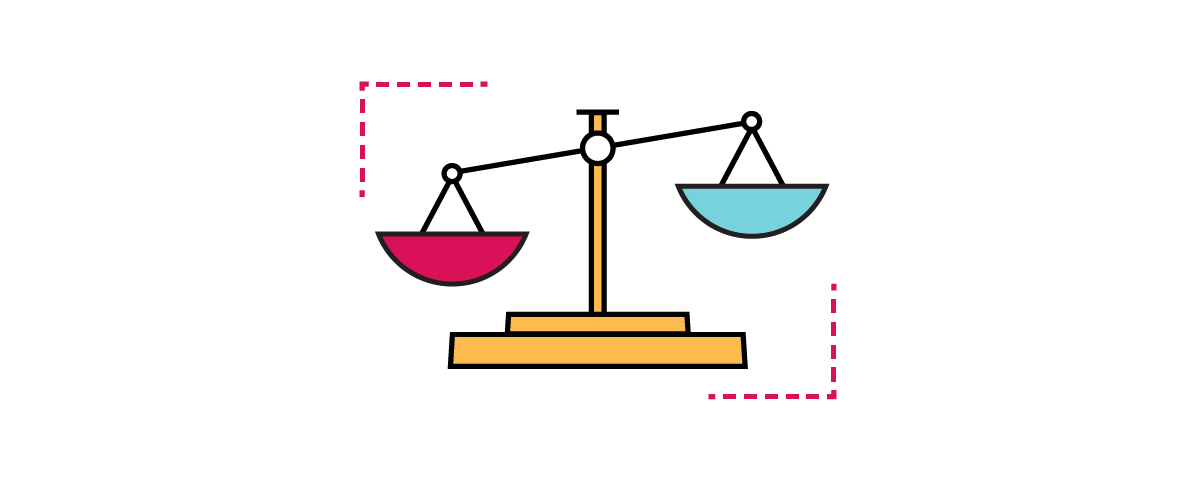Before diving into enhancements that can improve your website’s design, we need to understand the history and meet the “founding father” of B2B buyer journey concepts. In this article you’ll learn how you can use your website to increase conversion by supporting your potential customers as they navigate the buying process.
The “founding father” of B2B buyer journeys
The backbone of conversations regarding the B2B buyer journey dates back to the 1950s with a psychologist named Abraham Maslow. Many researchers have cited Maslow as one of the leading psychologists in studying human motivation and what human needs look like. His research culminated with what is called “Maslow’s Hierarchy of Needs.” Maslow provided a visual interpretation of the hierarchy starting at the bottom of the pyramid, which he labeled “Psychological”— these needs are universal human needs such as the need for water, food, and shelter. The following needs all the way to the tip of the pyramid are: safety, love/belonging, esteem, and self actualization.
Maslow said that human behavior and decision-making are derived from meeting these levels of this hierarchy. What’s interesting about Maslow’s research is that he provided it as a means for humanity to reach self-actualization— the tip of the pyramid. Self-actualization occurs when individual needs are continually met as they ascend to the tip of the pyramid. Individuals have problems related to one of the levels in the hierarchy of needs and, as they solve these problems, they ultimately achieve a level of betterment. This inward look into these individuals’ problems guided our framework today—directing us to look deeper into our own potential.
Marketers have done a good job of grasping Maslow’s work and have successfully applied it when mapping out B2B buyer journeys. Consumers make decisions when purchasing personal items as well as items for their organization. In reality, B2B buyers are looking to fulfill a desire they have to provide value to their organization.
Application of Maslow’s concepts in modern design
Understanding Andrew Maslow’s Hierarchy of Needs, we can now move forward in applying these concepts in modern web design and advertising. We’ll focus specifically on how marketers can gain a better understanding of how the different stages of the buyer journey can meet customer needs by providing informational and actionable content on your website.
What is B2B buyer journey mapping?
Customer journey mapping is the process of illustrating how clients engage with your products and services. A journey map highlights the events, motivations, and issues that are part of the typical brand experience had by B2B buyers, in this case.
A B2B buyer journey map is the first step to increasing sales and positive customer experiences for your organization. It’ll be important to create yours before making the optimizations listed in this article, which are just one step in the buyer journey mapping process. However, you can begin to outline your map as you read through our guide.
The buyer journey stages
It’s important to divide the different stages of the B2B buyer’s journey into these three stages (defined by HubSpot):
1 – Awareness:
In the “awareness” stage, the buyer realizes they have a problem and begins to conduct research to put a name to their problem.
2 – Consideration
Moving forward, the buyer now knows what their problem is and is researching options to help solve their problem.
3 – Decision
After exploring their options and understanding how these providers can solve their problem, the B2B buyer creates a list of vendors. After some thought, additional evaluation, and team collaboration, the B2B buyer will make a purchasing decision.
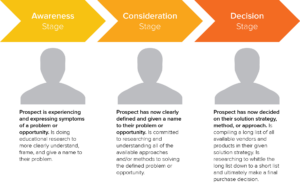
B2B buyer’s journey stages image credit: Hubspot
The awareness phase
At this stage of the B2B buyer journey, organizational stakeholders are discussing a problem that they have at their company and are defining specifications. “What does this problem mean for our team? Our customers? How will we be able to solve this issue? Are other companies experiencing this same problem?”
As a B2B marketer, this is your chance to move stakeholders into the first step of the sales cycle. As project stakeholders are diagnosing their issue, they are defining important topics and keywords that will help them conduct preliminary research as they are working to give a name to their issue. The following top of the funnel website enhancements will be valuable for you to implement to reach your B2B buyer during the awareness stage.
On-page search engine optimization (SEO)
Executing on-page and off-page SEO enhancements is vital to ensure that your organization appears during this initial research phase. Not only will you appear for relevant searches, but you’ll capture the attention of B2B decision makers. Make the investment or instruct your internal marketing team to create the following roadmaps and uncover relevant insights:
- Keyword research: What keywords are these B2B buyers searching? What problem terms are they looking up?
- Content marketing roadmap: What pages can be created or updated to support our main landing page? Are there blogs or news topics that we can expand on to provide additional education for our buyers?
- Audience research: Do we understand our audience? Their interests? Search tendencies? Demographics? Tailoring our content to meet these audience insights will increase engagement and the likelihood of conversion.
On-page SEO enhancements: Are we following best on-page SEO practices? Is the page optimized for bots and users
Not sure where to start? Contact Motion Tactic for SEO guidance and tips, or to start your SEO research and optimization campaign.
Landing pages with gated content
As B2B buyers work on preliminary research to define their problem, they’re typically looking for in-depth guides (white papers, research reports, etc.,) and case studies. Creating landing pages with these resources behind a “gate” (request for the user’s contact information before downloading the document), could help them identify the value and relevance of the resource, and expedite the sales process for marketers.
Blog content
Producing helpful content geared toward buyer search terms is a productive and efficient way to spend your time. As most marketers already know, blog post production requires a high level of research and writing. Dedicating several hours each week to developing content that answers a question related to the B2B buyer’s problem will prove successful. In each blog, make sure to link relevant pages and additional blogs that fall under the same category.
The consideration and decision making phases
At this point, the B2B buyer has defined their problem and are exploring different options for solving the issue, dropping users into the “consideration” and “decision” phase of their journey.
During the consideration and decision stage, the B2B buyer is looking for a solution that provides value for them at different levels. For example: if an organization determines that project management is a problem at their organization during the awareness phase, they likely will start their search for project management software— a software that provides value.
Providing buyers with intrinsic and extrinsic value
In a 2018 article in Harvard Business Review titled “The B2B Elements of Value,” strategists from Bain & Co extended Maslow’s Hierarchy of needs into a new pyramid that helps B2B suppliers understand buyer needs. The authors collected three decades of research to understand what matters most for B2B buyers. In short, the strategists determined that there are 40 elements of value that B2B buyers look for during the purchasing process. These 40 elements are split into 5 pyramid categories: table stakes, functional, ease of doing business, individual, and inspirational.
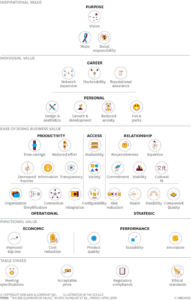
The B2B Elements of Value Pyramid credit: HBR
During the consideration phase, B2B buyers begin to analyze solutions based on the elements in the above pyramid. They are most attentive to the baseline “Table Stakes” elements at this stage, and ascend to the next phases of the pyramid as they narrow down their options . To reach the buyer and showcase your solutions’ value at every tier of this pyramid, marketers should be providing content on their website that appeals to the wide array of concerns, questions, and interests. You can address value elements of your product or service that appeal to B2B buyer concerns such as productivity, performance, operational, and strategic value by implementing the following resources on your website. Before making changes on your site, work with your marketing team to update your B2B buyer journey map with these opportunities. Planning in advance will eliminate mistakes and provide a clear picture of the buyer’s next steps.
- Live webinar embeds
- Webinar hubs
- Interactive product comparison tools
- Podcast recordings and a written copy of the discussion
- Live demos or video walk-throughs of your product or service
- Downloadable white papers and case studies
- Interactive walk-throughs of the product or service
B2B buyers are consuming these content types to vet leaders in the industry and evaluate the value of your solution over another.
“What if…?” (The importance of B2B buyer journey mapping)
The HBR article tells a story of a massive failure of a big B2B purchase that did not undergo enough due diligence during the consideration phase:
“Here the elements of value can address highly emotional concerns. A fear of failure often nags at buyers who spend large amounts of money and make decisions that may affect revenues or many employees. When you are purchasing mission-critical software, negotiating loans, or leasing real estate, the risks abound. Consider one U.S. telecommunications provider’s decision to upgrade its fiber-optic video service several years ago. It chose a China-based vendor that offered the lowest price and looked good on paper. Once installed, however, the new network was plagued with outages, and the telecom firm had to deal with technical support based 12 hours away in China. From the customer’s perspective, the vendor’s poor communication and relationship missteps—such as launching major changes without notice—were big problems. Though the firm eventually switched network vendors, it wasted a great deal of time and money and took a hit to its reputation with customers. This goes to show why some suppliers benefit from offering risk reduction and providing reputation protection to individuals who are accountable for purchases.”
To help B2B buyers avoid making a mistake during the decision phase, offering webinars or live demonstrations with real clients can be a valuable use of time for a buyer to consider your solution. During your webinar or demo, showcase how your solution will meet their organizational needs. To speak to the psychological concerns of your buyers, covering everything from motivation, perception, attitude, and learning depth. B2B buyers want to be fully informed and educated about how the solution in question would not only meet the needs for the organization, but that it would fulfill an inner desire to succeed at their company.
Taking action on your website
When a buyer creates a shortlist of suppliers who have a solution that meets their needs, your website should be optimized to include the following items (pushing the buyer from consideration to a decision). Be sure to layout your B2B buyer journey map before making the changes on your website. Following this structure will help members of your team stay organized and value-driven.
- Competitor comparisons: providing an objective grid of feature comparisons between the supplier and their competitors provide clarity between all available features within the solution.
- Contact options for a meeting or a demo: offering a quick and easy way for B2B buyers to speak to a sales or marketing representative from your company will often influence their decision to choose you over another vendor.
Training hub featuring implementation guides provide documentation about how to implement the solution successfully. Your documentation can be published as a gated, downloadable item, or as a simple webpage.
Including these resource types on your website will, in turn, help your buyer make an educated decision when purchasing.
Start Your B2B Buyer Journey Mapping
B2B buyers go through several stages before making their purchase. Do you have their journey mapped? Are you providing resources and materials that would help your buyers see the value in your product or solution? It’s critical that you’re in front of your customers through every stage of their journey. From awareness, to consideration and decision making, your website needs to offer information that helps them put a name to the issue, identify their solutions, and find value in your product or service.
As you’re formulating your journey map, reference Maslow’s Hierarchy of needs to provide resources that meet their needs to fulfill both the desire to make the right decision while simultaneously knowing that their career and perception may be influenced by a purchasing decision. Purchasers are faced with a variety of options when making a decision. Your ability to care about their wide variety of needs by providing content that meets stakeholder needs at each stage will allow your organization to stand out from the variety of other solution providers they are considering.
Motion Tactic specializes in B2B website design, contact us once you’re ready to improve your online buyers journey.
Tl;dr; The content that you develop on your organization’s website will be a guiding factor in the B2B buyer’s purchasing decision. Make sure your website is meeting the needs of your buyers from the awareness to consideration and decision making stage!
